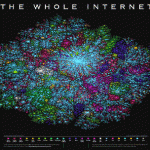Through a variety of intellectual discussions on communication, society, democracy and media, a recurrent reference is the concept of a transforming public sphere. With inspiration from sociologists like Richard Sennett and Jürgen Habermas, the public sphere as a theoretical framework is often used to explain contemporary civic participation and global interventions on political establishments (i.e. regimes). But what are the actual benefits of introducing this sociological perspective when trying to grasp current widening of the public sphere? In my case, in the process of conceptualizing the renewed interest for the public sphere as explanatory model for recent changes in the Arab world, it is useful to reflect on some historical background for this.
So, here goes..
The conditions for the emergence of a common public space where citizens from different social classes could meet and conduct a dialogue on politics and society, has most clearly been idealized and described by the sociologist Jürgen Habermas in his book The structural transformation of the public sphere (1962/1998). He presents a socio-historical endeavor on analytic grounds in which the division between private and public spheres during ancient Greece becomes the starting point. The journey then proceeds through the period between 1100 and 1600 which is characterized by a clear representative public sphere. This was acknowledged when politics became centralized to goods and palaces of the European aristocracy. The power were to be something on display for the public and it was the aristocracy who held it. But when a mercantilist political structure later emerges, the representative public sphere turns into a civil one, according to Habermas. This means that the more critical reasoning among citizens began to circulate around social issues and was constituted by a new upper middle class that emerged in conjunction to particular educational systems and an increased flow of information. The latter comes with a growing press where newspapers were to be the central organ for a more open information society. Exchange of opinions and critical reasoning concerning public affairs are what laid the foundation for the modern bourgeois public sphere across Europe.
In political terms, this allo symbolized the development of a contemporary transition from feudal thinking to more centralized state authority, and when simultaneous press systems were positioned as central actors of society, the traditional bourgeois public sphere dictated different conditions. With the centralization processes the state could exert a strong censorship over the press, which in turn led to a growing civic desire to break free from the domination of the political sphere.
Idealistic as well as real terms parliamentarism, stand for election, freedom of information, republic and voting shaped contemporary discourses which demands for free trade and freedom of the press had laid the groundwork for. The new bourgeois public sphere was critical by its nature and in the societal issues discussed, the role of government was often prominent.
In the beginning of the 1900s the political and social structures transformed once again and a clear shift in power was manifested in the transition from competitive capitalism to monopoly capitalism. The type of market freedom and free competition, safeguarded on during much of the 1800s, now adapted to a social structure where increased government intervention and power centering on different areas was driving. Habermas emphasizes this shift in power as the foundation of the structural transformation and downfall of the bourgeois (and critical) public sphere.
The conditions for citizens to form critical discussions and dialogues were changed and in the traces of monopoly capitalism the boundaries between state, market and citizens’ intimate sphere were dissolved. State economic intervention in the free market (in the form of taxes and legal restrictions) and the fact that concerns previously linked to the intimate sphere (such as health care) became institutionalized, this process led to the dissolvment of the bourgeois society. In this context one should also emphasize a parallel development; a form of colonization of the government when private interests, political parties and other organizations to some extent become a part of the state.
Similar reasoning is brought up in Richard Sennett’s book The Fall of Public Man (1974). Sennett explains how the community during the eighteenth century Enlightenment period provides favorable conditions for citizens to interact with each other on similar terms. Contemporary political and social dimensions of restoring balance between the public and private life emerged. This balance was disturbed, however, at the beginning of the 1800s. Both Habermas and Sennett points to industrial society and industrial capitalism’s emergence as main reasons for this change. According to Sennett the new economic and political framework helped shape new conceptions of citizenship in which people began to value the private (family relationships) higher than the public affairs, at least from a moral point of view.
The impact of the capitalist system was something from which citizens put great emphasis on trying to deviate from. In trying to protect themselves from the surrounding community, family and intimate spheres became central security points. Like Habermas, Sennett also sees how an increase in consumption (as a natural efffect of the new economy and politics) led to a rather confusing homogenization of people from different backgrounds, layers of society and classes. The conclusion from these fundamental changes in both the relation to as the essence of the public sphere, is that it manifested a clear civic position in that the core values that were associated with the private (warmth, love, relationships and community) was cemented and rated higher than public life where the dimensions of power and control was apparent. State, society and the public good was abandoned in favor of the protective intimate sphere and core values such as closeness, intimacy and relationships were perceived as positive, and particularly within the private sphere.
Sennett also emphasizes the significance of the media in the development of decosntructing the idealistic public sphere. He points out, among other things, that radio and television during the 1900s have further distanced people from the public sphere and relegated them to spectators of the same. Since the electronic media is generally used in the home, they contribute further to the privatizing tendencies of society.
Habermas and Sennetts ideals of a bourgeois public sphere are in other words deconstructed as a result of significant changes in the political, social as well as the media world. With a capitalist ideological rampage in much of the western world, the private becomes subject to economic and political interests. Habermas highlights how the communication context in a dialogic public (private citizens) was broken up and public opinion was turned to the informal opinions and also in large part to a publishing institutions of society that are driven by economic profit maximization. Citizens transgress from being involved in the shaping of public opinion to spectators to these journalistic institutions of formal opinion making that became the new, viewed, public sphere. The argument reveals Habermas’s critical attitude towards the modern mass media, its emergence and importance.
In realtion to this description of Habermas and Sennetts sociological perspective on public sphere and transformation, we can advantageously also apply the arguments on current the social and political state. Values and properties in the private (warmth, love, intimacy, passion, togetherness, community, etc.) are still valued in relation to the impersonal, cold and aloof public life. A public life that is separate from the intimate sphere, with all the specific core values that it involves, is thus not very attractive. But the development that has occurred in the late 1900’s and the beginning of the 21st century, or at least become most apparent during this time, is that it has progressed a reproduction of core values, a reintroduction of high moral values in the public sphere. Understandings that imply citizens to have control and power over their own persona and role in society, which had previously been firmly linked to the private sphere, has been transferred and incorporated even in the public life. And this is a very interesting dimension of late modern society and what makes it even more intricate is the fact that social change is no longer a narrow discussion in and of Western-oriented actors of society, but has become a global concern. Without making excessive claims to universalism or cosmopolitanism, it is necessary to emphasize the trends that appear to lead toward increased supranational and international consensus on the political conditions that shape our time and history.


